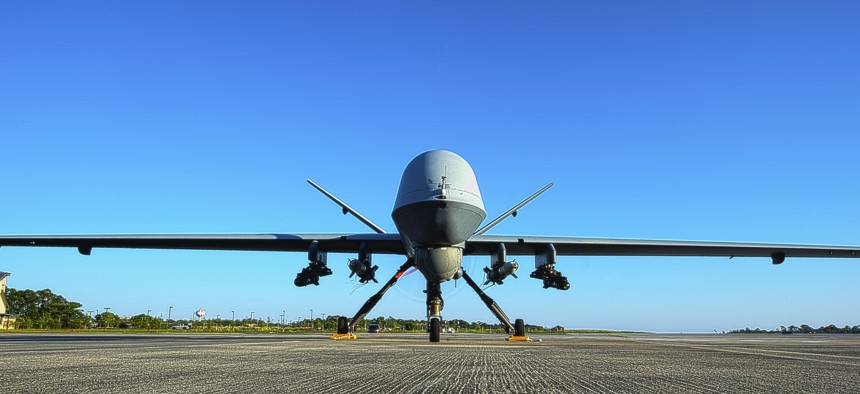
n MQ-9 Reaper sits on the flight line at Hurlburt Field, Fla., May 3, 2014. U.S. Air Force photo illustration/Staff Sgt. John Bainte
Air Force Trims Drone Ops to Get Workforce ‘Healthy’
The service is dropping five of its 65 combat air patrols so its overtaxed pilots and intelligence operators can catch their breath.
After spending much of the past decade racing to build up a cadre of drone pilots and aircraft, the Air Force is temporarily reducing the number of unmanned aircraft missions it flies. It’s not because demand is slacking off — UAVs remain in high demand in Iraq, where they search for Islamic State hideouts — but because the intense pace has pushed airmen to the breaking point.
On April 1, the service began reducing the number of combat air patrols it maintains from 65 to 60. This letup will help position this overtaxed arm of the Air Force for its next decade, service officials say.
“We’ve been able to come down off of 65 to help get the community and the enterprise healthy for that long-term sustainment that we want to be able to do,” said Col. James Cluff, who commands the 432nd Wing and 432nd Air Expeditionary Wing. Both wings operate out of Creech Air Force Base, the home of Air Force’s drone operations.
The Air Force measures its UAV capability by the number of targets it can watch around the clock. Keeping one drone over one target is called an orbit, or combat air patrol (abbreviated CAP). Each CAP generally requires four aircraft, a control station, antennas, and satellite communications — plus pilots, intelligence operators, maintainers, and more.
In 2008, the Air Force had enough UAV teams for 33 CAPs. Then-Defense Secretary Robert Gates prodded the service to keep adding them, and last May, the Air Force reached its all-time high of 65.

Cluff’s airmen fly the MQ-1 Predator and the larger MQ-9 Reaper, both in high demand by military commanders in the Middle East and Africa. Video from these aircraft is considered among the most valuable form of intelligence on the battlefield, and commanders’ thirst for it is often described as insatiable. No matter how fast the Air Force buys the drones, the service cannot train pilots and mission technicians quickly enough to meet the ever-growing demand. “[E]very day we are asked to produce as much as we possibly can and it’s still not enough,” Cluff said.
Their services are so valuable that the Air Force’s request to reduce its CAPs required the approval of Defense Secretary Ashton Carter. The long-term viability of the UAV force factored into the decision-making process, a senior defense official said.
Cluff said he took Carter’s approval as a sign that top Pentagon leaders understand that the drone community “was approaching the breaking point...We don’t have enough pilots and sensor operators in the near-term to make the community healthy.”
A former F-16 fighter pilot who has been in the unmanned aircraft world since 2007, Cluff defined “healthy” as having enough airmen to fill the billets within his wing, making sure they rise through the ranks, can get higher education, and have reasonable work schedules.
Staying at 65 CAPs would have had a long-term impact on training, safety, manning, retention, sustainment and combat capability, Lt. Col. Christopher Karns, an Air Force spokesman, said.
“[W]e recognized that the path we were on was going to take us to much less capability,” Cluff said. “Until we can get enough people in the community to sustain those numbers, we’re not healthy.”
By slowing down to 60 CAPs, Air Force leaders buy some time to figure out how many UAV airmen it needs for the next five to 10 years, Cluff said.
It will also allow the Air Force to surge above 65 CAPs to meet an emergency, Cluff said.
After dragging its feet for years, the Air Force spent the latter part of the past decade racing to put drones in the air over Afghanistan and Iraq. In many cases, the aircraft pilots flew their drones from temporary trailers at Creech Air Force Base, about 40 miles outside of Las Vegas. While the base has grown, and brick and mortar facilities have risen, the Air Force as a whole has gotten smaller. And the UAV community is made up of a lot of people.
Each combat air patrol involves hundreds of people, the pilots, sensor operators who control the cameras on the planes and dozens of intelligence analysts who review hours of video feeds and interpret information. Closer to the battlefield, maintainers launch, recover and repair the aircraft that are not flying.
Unmanned aircraft are a vital tool in the counterinsurgency battles in Iraq and Afghanistan since they can stay airborne for a day, unlike manned aircraft where pilots must return to their bases for rest after a period of time.
“The reality of the wars we’re fighting right now is that 60 is not enough,” Cluff said. “The Air Force struggles to produce more than that.”




